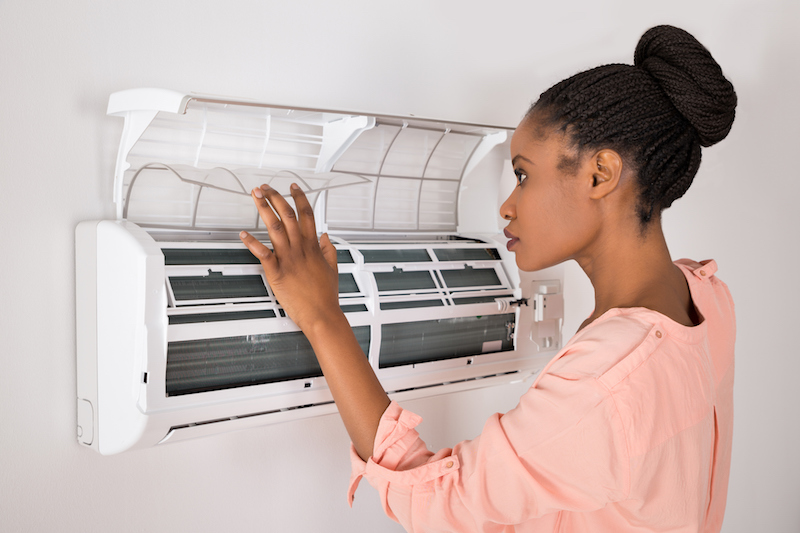
You shouldn’t be forced to compromise on comfort or drain your wallet to keep your house at a refreshing setting during warm days.
But what is the ideal setting, exactly? We go over ideas from energy pros so you can determine the best temperature for your family.
Here’s what we suggest for the most energy-efficient setting for air conditioning in Payson.
Recommended Thermostat Settings for Summer
Most households find using the thermostat at 72-73 degrees is ideal. However, if there’s a huge difference between your interior and outside temps, your utility costs will be larger.
These are our suggestions based on the U.S. Department of Energy (DOE) and ENERGY STAR®.
While at home: 78 degrees. While that appears warm, there are methods you can keep your house pleasant without having the air conditioner on constantly.
Keeping windows and window treatments shut during the day keeps chilled air where it belongs—within your home. Some window treatments, such as honeycomb shades or plantation shutters, are designed to deliver extra insulation and enhanced energy savings.
If you have ceiling fans in your residence, the DOE says you can move thermostat settings about 4 degrees hotter without giving up comfort. That’s since they cool through a windchill effect. As they cool people, not rooms, turn them off when you move from a room.
If 78 degrees still feels too uncomfortable on the surface, try doing a trial for about a week. Begin by raising your thermostat to 78 degrees while you’re home. Then, progressively turn it down while following the advice above. You might be amazed at how refreshed you feel at a warmer temperature setting.
While away: 88 degrees. There’s no reason to keep the air conditioner going all day while your home is empty. Moving the temperature 7–10 degrees warmer can save you anywhere from 5–15% on your electrical bills, according to the DOE.
When you arrive home, don’t be tempted to switch your thermostat colder than 78 to cool your house faster. This isn’t effective and usually produces a bigger electrical expense.
A programmable thermostat is a helpful way to keep your temperature in check, but you have to set programs. If you don’t set programs, you risk forgetting to move the set temperature when you go.
If you want a hassle-free fix, think over getting a smart thermostat. This thermostat works with with your phone, so it is aware when you’re at home and when you’re out. Then it automatically changes temperature settings for the biggest savings. How much exactly? Usually $180 each year on heating and cooling, according to ENERGY STAR.
Another benefit of having a smart thermostat? You can use your phone to keep an eye on and change temperature settings from just about anywhere.
While sleeping: Around 70 degrees. While ENERGY STAR suggests 82 degrees, that may be unpleasant for many families. Many people sleep better when their bedroom is chilled, so that’s why the National Sleep Foundation advises 60–67 degrees. But that may be too cold, depending on your clothing and blanket preference.
We advise running a similar test over a week, moving your temp higher and slowly decreasing it to locate the best setting for your residence. On cool nights, you could learn keeping windows open at night and using a ceiling fan is a better idea than running the air conditioner.
More Ways to Use Less Energy During Warm Weather
There are other ways you can conserve money on energy bills throughout the summer.
- Buy an energy-efficient AC system. Central air conditioners only last about 12–15 years and lose efficiency as they get older. A new air conditioner can keep your residence cooler while keeping utility bills down.
- Book regular air conditioner service. Regular air conditioner maintenance keeps your unit working properly and might help it run at greater efficiency. It can also help extend its life cycle, since it enables pros to spot small troubles before they lead to a major meltdown.
- Switch air filters regularly. Use manufacturer instructions for switching your air filter. A dirty filter can lead to your system short cycling, or switch on and off too often, and drive up your electrical.
- Measure attic insulation levels. Nearly 90% of houses in the U.S. don’t have proper insulation, according to the Insulation Institute. Most southern climates need 13–14” of attic insulation, while northern climates should have 16–18”.
- Have your ductwork checked. Ductwork that has loosened over time can let cold air into your attic, walls or crawl space. This can create major comfort issues in your residence, including hot and cold spots.
- Seal holes, doors and windows. Keep muggy air in its place by plugging openings. You can also caulk or weather strip doors to trap more cold air indoors.
Conserve More Energy During Hot Weather with North Mechanical Heating and Cooling
If you want to save more energy this summer, our North Mechanical Heating and Cooling experts can provide assistance. Reach us at 928-263-8570 or contact us online for additional information about our energy-saving cooling products.
